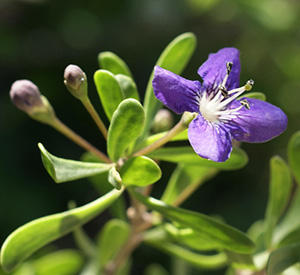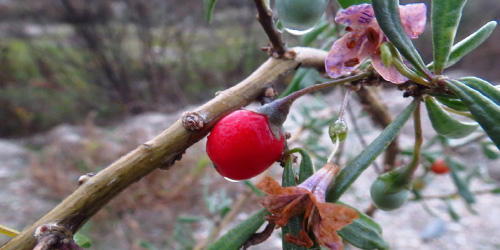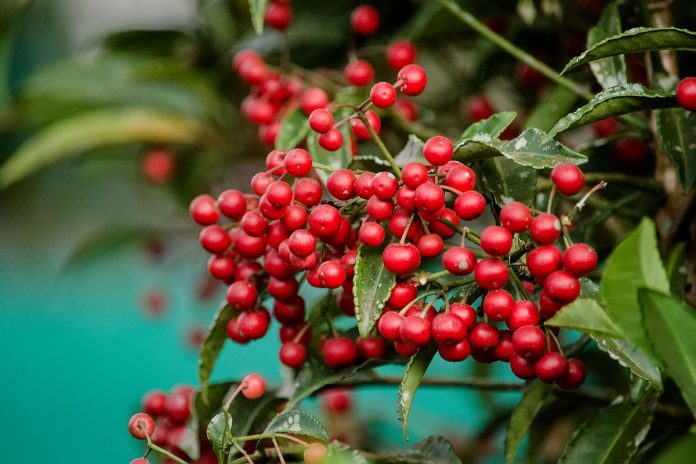The Goji berry has appeared in recent years as a superfood with strong anti-oxidant concentrations. It is stated to have the properties of anti-aging, anti-cancer and anti-disease and a host of other benefits for the body’s systems.
However, these advantages come at a high price – $12/lb or more. But there is a Goji berry relative that you can harvest from the wild — or grow it in your garden. Lycium carolinianum, the Christmas berry, also called Carolina wolfberry, is the plant I know about and write about here. There are some 70 to 80 Lycium types, many of which are present in the United States. Some have therapeutic value but not all. Research the varieties found near you to ensure they are both edible and medicinal.
Identify Christmas Berries

The Christmas berry is a perennial member of Solanaceae, the nightshade family. The plants are thorny evergreen shrubs, which grow to three to twelve feet tall, with three to six feet of spread.
The tiny, narrow leaves are arranged in turn. The fleshy, succulent leaves are elongated on the tip and rounded. The branches and plump leaves resemble the stems of the rosemary except that the leaves on the tip are flattened and rounded.
Every plant has several woody stems sprouting flowers and supporting the berries. The flowers are funnel-shaped and single or arranged in small clusters, in color blue or mauve, attracting butterflies.
The flowers have parts both male and female, and are pollinated with bees. It should be noted that Lycium carolinianum flowers have four petals, whereas there are five other members of the Lycium family.
Christmas berries have a diameter of up to a half inch. The fruit typically ripens from October to April, and is a source of food for local birds. The red berries can be found in some areas year round.
Where to Find Christmas Berries
It can be found in the Southeast, in salt marshes, sand dunes and coastal areas. It grows well in areas 7 to 10, but zone 5 is reported to be hardy.
The plants are resistant to salt, and can withstand strong winds. You will typically find plants potted in native plant nurseries, if you want to cultivate them.
Edible Use of Christmas Berries
The ripe fruit is edible, whether cooked or raw. The flavor is sweet, sour and a little bit salty. Only fully ripe fruit should be eaten; avoid fruits that are not entirely red in color. Some plant parts aren’t edible.

Related: Why You Should Put Peppers In Your Socks
Medicinal Use of Christmas Berries
The berries, like their cousin, the Goji berry, are an excellent source of antioxidants and numerous vitamins and minerals including vitamins A, C, E, flavonoids and essential fatty acids.
The berries are currently being researched for their role in the prevention and treatment of cancers. Early evidence shows that some cancers, including skin cancer, can be prevented and in some cases, the disease can be reversed.
Lycium carolinianum is just beginning to be studied for its health benefits, but our grandmothers used it regularly as an anti-aging tonic and a treatment for many of the ageing diseases, including ischemic stroke, nerve inflammation, and eye-related issues.
It is also thought to be helpful in the treatment of diabetes and many of the diabetes-related problems such as high blood sugar, high blood pressure, and prevention of retinal decay.
The berries enhance the immune system and protect the liver, thus helping the body heal from any disease. It helps build the blood in anemic and fatigued individuals.
Irritations to the skin, burns, and wounds also benefit from eating the berries, drinking the juice, or tea washing.
Other Reported Uses For Christmas Berries:
- Controls cholesterol levels
- Protects the heart
- Improves gastrointestinal function
- Reduces stress and fatigue
- Protects the liver
- Improves sleep
- Protects the eyes from degenerative diseases
- Protects from the flu
- Improves erectile dysfunction
- Helps mental focus
Eating Lycium Carolinianum
Christmas berries can be eaten whole, either raw or baked, dried and powdered or juiced for later use. Tea may also be prepared from dried berries and drunk hot or cold, or used as a topical skin wash
A small handful of everyday Christmas berries is adequate to get medicinal benefits. I apply a few ounces of the dried berries to my smoothie in the morning.
To retain their nutritional and medicinal value, they have to be harvested by hand and processed within 24 to 48 hours. Just harvesting beers which are fully mature and display no signs of being over-ripe. The berries are easy to spoil, so just pick as many as you can at a time. They can keep the plant healthier.
Is Lycium Carolinianum Safe?
If you are pregnant or breastfeeding, do not use Lycium carolinianum-there is no evidence demonstrating their protection for pregnant women or their infants. In addition, it has confirmed miscarriages.
Christmas berries have no documented toxic effects, but it is important to remember that it is a member of the nightshade family. Nightshades have several toxic members, so it makes sense to be sure of your plant identification and start using it slowly. Some people are allergic to nightshades, which can have side effects.











